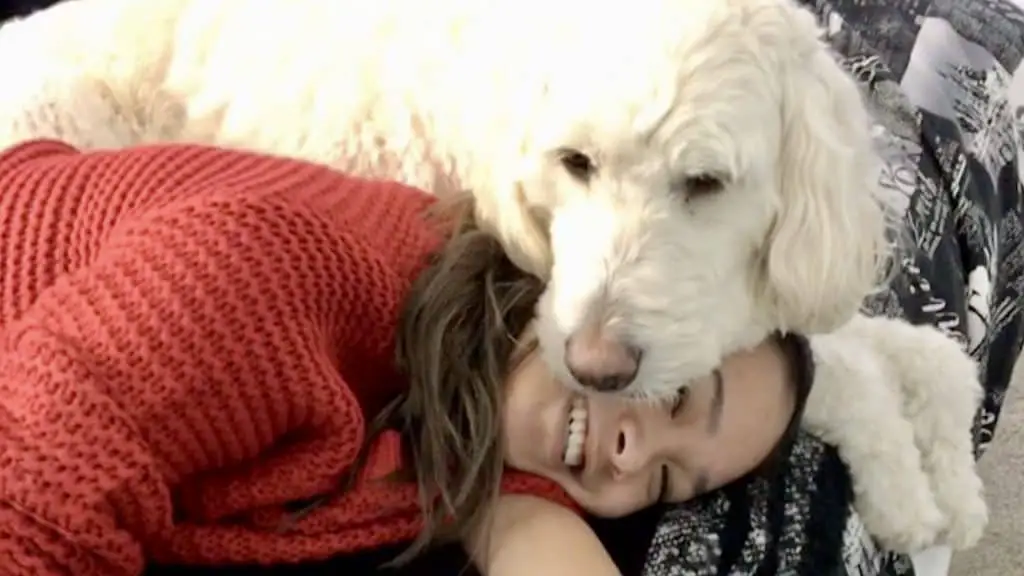As with many other typical dog behaviors, a dog that sits on its owner could have various reasons for doing it. I find that our Goldendoodle loves to sit on my foot or cram as close to my leg as possible.
As a general rule, your dog sits on you because they trust you, and sitting beside you isn’t close enough for them. A dog will use this behavior to either communicate something to his owner or other pets or people around, from the desire for affection to a show of dominance.
In general, this behavior is acceptable and endearing. It is a sign that your dog loves you and wants to be near you. However, knowing why your dog is sitting is essential if you don’t want to reinforce your dog’s dominance accidentally.
Six Reasons Your Dog May Be Sitting On You
Generally, the behavior is quite flattering and adorable for any dog owner. Whether you have a large or small dog, when it comes up to you and chooses to sit with you, jumping on your lap to get as close to you as he possibly can, you feel special and loved.
You may love it so much that you don’t so much as give it a second thought as to what message your dog is sending and what they might say about his relationship to you or others.
It is essential to understand our dogs and know when something is a sign of health and happiness and when something could be a sign that something is off.
To do so, you must be attuned to your dog and understand basic dog body language. You will want to note your dog’s eyes, mouth, tail, and overall posture to understand what your dog is saying or feeling.
Because there are a few negative reasons your dog may sit on you, be sure you understand what behaviors may accompany your dog sitting with you to know if you need to take any action.
Your Dog Sits On You For Cuddles and Affection
If your dog comes up to you gently and calmly, with light touches and nuzzling, he probably wants to be pet and cuddled. This behavior mimics that of a puppy and its mother.
You may not want your dog demanding attention like this, but dogs also need affection, and if you are not faithfully providing them with attention and companionship, you can hardly blame them.
If the behavior truly is unacceptable to you, teach your dog to sit at your side instead or lie down elsewhere and wait. However, if you don’t have time for cuddling and loving a dog, consider getting a different pet altogether.
It May Be An Invitation to Play
Often a dog will come up and sit on you with more purpose than just for cuddles. If their overall posture exudes energy, it may be your dog wants to play.
Pawing is an invitation to wrestle or roughhouse. If he brings you a toy, it may be he wants to play tug or want you to throw it.
Other indications your dog wants to play are the fake bow, slapping his front legs on the ground in front of you, or rolling over onto his back with his mouth open and his ears relaxed.
Again, it may not be acceptable for your dog to demand your attention this way, but be sure you are spending quality time with your dog every day, playing with him, and ensuring he gets adequate exercise.
Marking You as Theirs
Sitting on you is one way that dogs mark you as their owner. They claim you. This is common when other dogs or pets, or even people, come over since the dog will want to make sure that everyone knows you’re his.
This can go too far, however, and cross over into aggression. If a dog barks or growls at anyone who comes near, or nips at other pets, you will need to address this behavior.
Your dog will need to learn not to be overly protective, especially if it makes him aggressive or dangerous to others.
Breeds of Affection
It may be that you have an exceptionally affectionate breed of dog. Lapdogs were primarily bred to be companion dogs, so it should come as no surprise if they want to sit on you. Breeds like the Shih Tzu, Maltese, Pug, and Bichon Frise are particularly cuddly.
In addition to wanting to be with you, some smaller breeds of dogs have the added motivation to sit with you, be up higher off the ground, away from bigger animals or children.
But small or toy breeds aren’t the only breeds known for loving to sit with their owners. Great Danes and Mastiffs, two of the largest dogs’ breeds, also love to sit with their owners, seemingly unaware of how huge they are.
Fear and Anxiety
If your dog suffers from separation anxiety, it may be his wanting to be in your lap is because he is afraid of leaving you or you going him. This would indicate that some action on your part is necessary to teach him not to be anxious about you.
It is unhealthy for dogs to suffer stress and fear like this, and it can lead to a lot of undesirable and even dangerous behaviors. If your dog is prone to other behaviors related to separation anxiety, consider beginning to work with him on that and providing for him so that he can learn to be calm in your absence.

Dominance Over You
This would be another example of a reason that would require your interference. If your dog sits on you and is snappy or growls at you or other animals or people, you probably have an aggression problem.
Other signs that might indicate your dog thinks he runs the place would be if he continually pulls at his leash, doesn’t come when called, jumps on you or others, barks when he doesn’t get his way, won’t listen to any commands, or is pushy about getting attention.
These behaviors are highly unacceptable and need to be eradicated if you have a respectful and well-mannered dog.
Actions Moving Forward
It may be that your dog loves you and wants to be with you. In that case, there is no need to take any action with your dog unless, of course, you don’t like him sitting on your lap or it is potentially dangerous due to his size. In such cases, you can teach him to sit or lie contentedly beside you.
If your dog displays signs of clinginess or aggression, however, you will need to address the problem of him sitting on your lap. Frequently these problems relate directly to improper socialization or a lack of consistent training.
Getting back on track will be very important in remedying difficulties of separation anxiety or dominance. Take your dog to training classes or a dog behaviorist to have help with the process.
Lastly, some dogs become aggressive or pushy when they are in pain. It may seem that your dog’s behavior relates to some underlying health condition.
Before assuming your dog is just poorly behaved, take him to be examined by a vet. It may be that he is in pain or uncomfortable.
In Closing
In general, a dog who chooses to sit in your lap is a dog who loves you and wants to be with you. He wants to love and companionship, and you can give that to him.
There is no need to be concerned unless you don’t like him sitting on you, in which case, you can train him to sit near you, but not on you.
In a few cases, sitting on you may be a sign of a more serious issue, so be sure to look for any accompanying behaviors that may indicate aggression or anxiety.
Learn to read your dog well and take the time necessary to socialize him and train him so that you can have a loving but also respectful friend.
